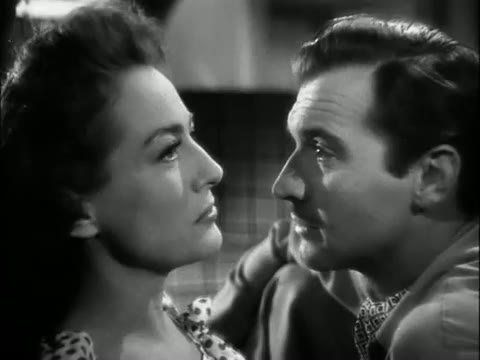Réalisation:
Michael CurtizPhotographie:
Ernest HallerMusique:
Max SteinerActeurs·trices:
Joan Crawford, Jack Carson, Zachary Scott, Eve Arden, Ann Blyth, Bruce Bennett, Lee Patrick, Moroni Olsen, Veda Ann Borg, Jo Ann Marlowe (plus)VOD (1)
Résumés(1)
Une élégante femme en manteau de vison est interrogée dans un commissariat. Son mari, Monte Beragon, été retrouvé mort à leur domicile. Mildred Pierce commence alors le récit de sa vie passée. Lors de son premier mariage, Mildred est une femme au foyer sans prétentions, régalant le quartier de ses gâteaux et s’occupant de ses deux filles, Kay et Veda. Lorsqu’elle apprend que son mari la trompe, elle demande aussitôt le divorce et se retrouve dans une situation précaire. De plus, son ainée Veda, adolescente capricieuse et gâtée, lui rend la vie impossible. Pour satisfaire ses goûts de luxe, Mildred travaille d’arrache pied dans un dinner. Elle parvient enfin à ouvrir son propre restaurant, grâce à l’aide du séduisant Monte Beragon. Parce qu’il est riche et qu’il peut leur offrir une vie de rêve, Mildred consent à l’épouser. Mais quel drame se cache derrière ce récit bourgeois et ce sordide meurtre ? (LaCinetek)
(plus)Critiques (3)
Starring the captivating Joan Crawford, who may not be the symbol of a Hollywood beauty like her enormous rival Bette Davis, but that doesn't change the fact that watching her as the main character is simply worth it. An unbelievable actress. Yes, the story has its weaknesses, but the way it is portrayed by the actors compensates for some moments on its own.
()
An unusual noir film (going back to the past, a voice over, murder, chiaroscuro) that goes so far into the breakdown of a family that it pits a daughter (femme fatale) against her mother, who is guilty of trying to achieve the American Dream on her own. The message is clear and, like in other noir films, not very kind to persons of the gentler sex: women abandoned during the war should stop playing around and go back to their men. Unlike Cain’s book on which the film is based, the film does not emphasise the social dimension of Mildred’s situation – the plot was shifted from the time of the Great Depression to the 1940s and instead of a woman without hope, it presents an aggressive woman, a vamp in whose case we spend most of the film wondering whether or not she committed the murder that opens the film. The denouement doesn’t change anything with respect to who is guilty, but only to what they are guilty of. The traditional noir irreversibility of the initial situation is highlighted twice. The film does not ask for our compassion and the melodramatic idyll in it is always only ostensible and reinforced by ulterior interests. In spite of that, we can take Mildred Pierce, a feminine noir film, as an example of the incomprehensibility of this genre (genre?) of post-war American cinema. 80%
()
Mildred Pierce in this original version is absolutely crazy. The whole narrative is quite different from what Cain's book offers us. The crime framework shifts the whole anabasis around Mildred and her business into a different genre, it lacks the emphasis on the Great Depression, and the direction of the daughters is also different, and so is the finale. Joan Crawford is in her element, wearing outrageous costumes in that edgy 40s silhouette and sprinkling stardust around her even though she's only wearing a kitchen apron. I like all the changes, so typical of Hollywood at the time, and I'm equally glad that HBO mini brought an almost literal adaptation for a change years later. Here, no stone is left unturned and few aspire to win the audience's sympathy, while the novel offers characters of far greater color. However, one cannot be separated from the other; the novel, the film, and the series form a rare package of excellent experiences.
()

